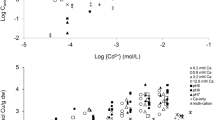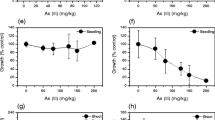Abstract
Legume root nodules are the site of biological nitrogen fixation in theRhizobium-legame symbiosis. Nodules are structures unique to this symbiosis and they are morphologically as well as physiologically distinct from other plant organs. Organic substances affecting the macro- or microsymbionts vitality, such as PAHs (Wetzel et al., 1991), reduce nodulation even before visible damage to the plant can be detected. We present data that the formation of nodules (nodulation) may also serve for ecotoxicological evaluation of heavy metals in different binding states.
Tests were performed in petri dishes with alfalfa (lucerne) seedlings inoculated withRhizobium meliloti. Cultivation took place in growth cabinets with carefully standardized and documented growth conditions. Data from stressed plants was recorded after 14 days of cultivation on contaminated substrate. A dose responsive decrease in nodulation was found after application of cadmium acetate, cadmium iodide, cadmium chloride, sodium salts of arsenate and arsenite, arsenic pentoxide, and lead nitrate, whereas lead acetate showed no effect up to a concentration of 3 μM. The dose response curves were used to calculate EC10, EC50 and EC90 values. EC50 values for cadmium compounds range from 1.5 to9.5 pM. Testing different arsenic compounds results in EC50 from 2.6 to 20.1 μM. EC50 of lead nitrate is 2.2 μM. The sensitivity, reproducibility and reliability of this test system is discussed compared to established biotests.
Similar content being viewed by others
References
Angle J.S.;McGrath S.P.;Chaudri A.M.;Chaney R.L.;Giller K.E.: Inoculation effects on legumes grown in soil previously treated with sewage sludge. Soil Biol. Biochem. 25: 575–580 (1993)
ATSDR — Agency for Toxic Substances and Disease Registry: Toxicological profile for arsenic. Atlanta U.S. Department of Health and Human Services, Public Health Service (1993)
Caetano-Anollés G.;Gresshoff P. M.: Efficiency of nodule initiation and autoregulatory responses in a supernodulating soybean mutant. Appl. Env. Microbiol. 57: 2205–2210 (1991)
Chino M. In:Kitagishi K.;Yamane I. (Eds.) Heavy metal pollution in soils of Japan. Sci Soc Press, Tokyo, 65–80 (1981)
Codina J.C.;Perez-Garcia A.;Romero P.;de Vicente A.: A comparison of microbial bioassays for the detection of metal toxicity. Arch. Environ. Contam. Toxicol. 25: 250–254 (1993)
DIN 38 412 Teil 34: Bestimmung der Hemmwirkung von Abwasser auf die Lichtemission vonPbotobacterium phosphoreum - Leuchtbakterien-Abwassertest mit konservierten Bakterien (L34). Testverfahren mit Wasserorganismen (Gruppe L). (1991)
Falbe J.;Regitz M.: Römpp Chemie Lexikon. 9. Auflage, Thieme Verlag, Stuttgart New York (1989)
Graham P.H.;Draeger K.J.;Ferrey M.L.;Conroy M.J.;Hammer B.E.;Martinez E.;Aarons S.R.;Quinto C.: Acid pH tolerance in strains ofRhizobium andBradyrhizobium, and initial studies on the basis for acid tolerance ofRhizobium tropici UMR 1899. Can. J. Microbiol. 40: 198–207 (1994)
IARC; Overall Evaluations of Carcinogenicity: Lead [7439-92-1] and lead compounds, inorganic; Lead, organo [75-74-1], [78-00-2] An Updating of IARC Monographs Volume 23, Supplement No. 7 (1987)
IARC; Some inorganic and organometallic compounds; IARC Monographs on the Evaluation of Carcinogenic Risks to Humans, Volume 2 (1973)
IARC; Some metals and metallic compounds; IARC Monographs on the Evaluation of Carcinogenic Risks to Humans, Volume 23 (1980)
IARC; Beryllium, cadmium, mercury and exposures in the glass manufacturing industry; IARC Monographs on the Evaluation of Carcinogenic Risks to Humans, Volume 58 (1993)
ISO/DIS 11268-2: Soil Quality — Effects of pollutants on earthworms (Eisenia fetida) - Part 2. Method for the determination of effects on reproduction. (1994)
ISO 11269-1: Soil Quality — Determination of the effects of pollutants on soil flora — Part 1. Method for the measurement of root growth. (1994)
ISO/DIS 11269-2: Soil Quality — Determination of the effects of pollutants on soil flora — Part 2. Effects of chemicals on the emergence and growth of higher plants. (1994)
Landberg T.;Greger M.: Influence of selenium on uptake and toxicity of copper and cadmium in pea (Pisum sativum) and wheat (Triticum aestivum). Physiologia Plantarum 90: 637–644 (1994)
Liebig G.E;Bradford G.R.;Vanselow A.P.: Soil Sci. 88: 342–348 (1959)
Ligero F.;Caba J.M.;Lluch C.;Olivares J.: Nitrate inhibition of nodulation can be overcome by the ethylene inhibitor aminoethoxyvinylglycine. Plant Physiol. 97: 1221–1225 (1991)
Lussen H.;Rahman A.: Wurzellängentest mit Gartenkresse — ein einfacher ökotoxikologischer Test. Vom Wasser 54: 29–35 (1980)
Peters N.K.;Long S.R.: Alfalfa root exudates and compounds which promote or inhibit induction ofRhizobium meliloti nodulation genes. Plant Physiol. 88: 396–400 (1988)
Streit B.: Lexikon Ökotoxikologie. 1. Auflage, Verlag Chemie, Weinheim (1991)
Wallnöfer P.R.;Engelhardt G.: Schadstoffe, die aus dem Boden aufgenommen werden. In: Schadwirkungen auf pflanzen.Elstner E.F.;Hock B. (Eds.), BI-Wiss.-Verl., Zürich, 95–117 (1988)
Werner D.: Pflanzliche und mikrobielle Symbiosen. 1. Auflage, Thieme Verlag, Stuttgart New York (1987)
Wetzel A.;Klante G.;Werner D.: Biotoxizitätstests mit PAK - Die Nodulation in der Leguminosen-Rhizobien-Symbiose als sensibler Wirkungsparameter. UWSF — Z. Umweltchem. Ökotox. 3: 66–271 (1991)
Wetzel A.;Werner D.: Ecotoxicological evaluation of contaminated soil using the legume root nodule symbiosis as effect parameter. Environmental Toxicology and Water Quality 10: 127–133 (1995)
Wetzel A.;Parniske M.;Werner D.: The pleiotropic effects of fluoanthene on anthocyanin synthesis and nodulation ofMedicago sativa is reversed by the plant flavone luteolin. Bull. Environ. Contam. Toxicol. 54: 633–639 (1995)
Wichmann H.E.;Schlipköter H.W.;Fülgraf G.: Handbuch der Umweltmedizin. 3. Lieferung, ecomed Verlag, Landsberg (1993)
Zierdt M.: Umweltmonitoring mit natürlichen Indikatoren. 1. Auflage, Springer Verlag, Berlin Heidelberg New York (1997)
Author information
Authors and Affiliations
Rights and permissions
About this article
Cite this article
Neumann, H., Bode-Kirchhoff, A., Madeheim, A. et al. Toxicity testing of heavy metals with theRhizobium-legume symbiosis: High sensitivity to cadmium and arsenic compounds. Environ. Sci. & Pollut. Res. 5, 28–36 (1998). https://doi.org/10.1007/BF02986371
Received:
Accepted:
Issue Date:
DOI: https://doi.org/10.1007/BF02986371
Keywords
- Alfalfa,Rhizobium-legame symbiosis, biotest, toxicity testing
- biotest, toxicity testing, heavy metals,Rhizobium-legame symbiosis
- ecotoxicology, toxicity testing, heavy metals
- heavy metals, toxicity testing,Rhizobium-legame symbiosis
- lucerne,Rhizobium-legame symbiosis, biotest, toxicity testing
- nodulation,Rhizobium-legame symbiosis, toxicity testing, heavy metals
- Rhizobium-legame symbiosis, toxicity testing, heavy metals
- symbiosis,Rhizobium-legame symbiosis, toxicity testing, heavy metals
- sensitivity, heavy metals
- toxicity testing, heavy metals,Rhizobium-legame symbiosis




